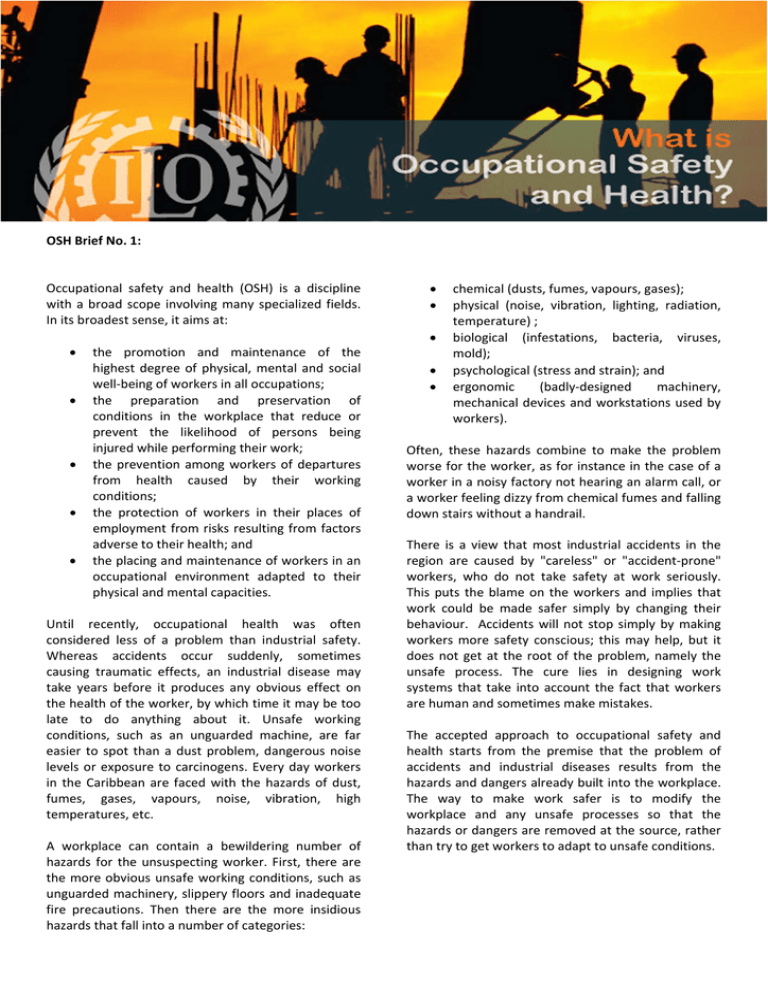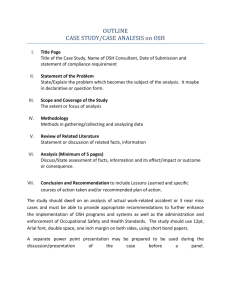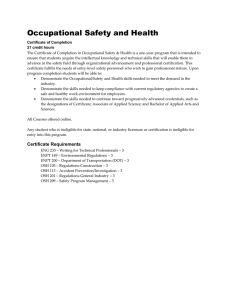What is OSHE pdf
advertisement

OSH Brief No. 1: Occupational safety and health (OSH) is a discipline with a broad scope involving many specialized fields. In its broadest sense, it aims at: • the promotion and maintenance of the highest degree of physical, mental and social well‐being of workers in all occupations; • the preparation and preservation of conditions in the workplace that reduce or prevent the likelihood of persons being injured while performing their work; • the prevention among workers of departures from health caused by their working conditions; • the protection of workers in their places of employment from risks resulting from factors adverse to their health; and • the placing and maintenance of workers in an occupational environment adapted to their physical and mental capacities. Until recently, occupational health was often considered less of a problem than industrial safety. Whereas accidents occur suddenly, sometimes causing traumatic effects, an industrial disease may take years before it produces any obvious effect on the health of the worker, by which time it may be too late to do anything about it. Unsafe working conditions, such as an unguarded machine, are far easier to spot than a dust problem, dangerous noise levels or exposure to carcinogens. Every day workers in the Caribbean are faced with the hazards of dust, fumes, gases, vapours, noise, vibration, high temperatures, etc. A workplace can contain a bewildering number of hazards for the unsuspecting worker. First, there are the more obvious unsafe working conditions, such as unguarded machinery, slippery floors and inadequate fire precautions. Then there are the more insidious hazards that fall into a number of categories: • chemical (dusts, fumes, vapours, gases); • physical (noise, vibration, lighting, radiation, temperature) ; • biological (infestations, bacteria, viruses, mold); • psychological (stress and strain); and • ergonomic (badly‐designed machinery, mechanical devices and workstations used by workers). Often, these hazards combine to make the problem worse for the worker, as for instance in the case of a worker in a noisy factory not hearing an alarm call, or a worker feeling dizzy from chemical fumes and falling down stairs without a handrail. There is a view that most industrial accidents in the region are caused by "careless" or "accident‐prone" workers, who do not take safety at work seriously. This puts the blame on the workers and implies that work could be made safer simply by changing their behaviour. Accidents will not stop simply by making workers more safety conscious; this may help, but it does not get at the root of the problem, namely the unsafe process. The cure lies in designing work systems that take into account the fact that workers are human and sometimes make mistakes. The accepted approach to occupational safety and health starts from the premise that the problem of accidents and industrial diseases results from the hazards and dangers already built into the workplace. The way to make work safer is to modify the workplace and any unsafe processes so that the hazards or dangers are removed at the source, rather than try to get workers to adapt to unsafe conditions. Accidents in the workplace Accidents are caused by unsafe acts or unsafe conditions or a combination of both. Research has shown that no accident ever has a single cause. The International Loss Control Institute puts forward a theory of accident causation suggesting multiple causes for accidents such as: • the lack of management control, that is, the lack of a Safety and Health Management System; and • indirect causes (root causes): • procedural (organizational factors) • technical (job factors) • behavioural (personal factors) • immediate causes (direct causes), the acts or conditions that precipitated the event. They are often easily recognized but addressing these symptoms alone will not prevent recurrence. When an accident occurs, what we observe is the immediate cause. However, there are a number of factors impacting on the situation which could have led to the final outcome. Indirect or root causes could have created the initial deficiencies leading to the final outcome. Factors endemic to accident causation • Procedural factors such as inadequate work standards or procedures, poor communication and coordination of activities and inadequate supervision. • Technical factors such as the design and layout of equipment, inadequate maintenance, equipment and material selection and use. • Behavioural factors such as physical and mental capabilities, lack of knowledge and information relevant to performing the task, stress and boredom as well as a lack of the necessary skill to carry out the task. • Lack of management control implying that there was no management system in place. This leads to an inadequate safety culture. The organizational safety culture is determined, amongst other things, by: • management’s commitment to making OSH a core value of the organization, on par with production; • active participation of workers at all stages (planning, implementation and review of OSH programmes); • encouraging a culture of reporting of accidents and incidents; the prompt investigation of accidents and incidents; the communication of information about the hazards and their control measures in the tasks being performed; the provision of adequate supervision; and continually improving OSH performance. • • • • Benefits of investigating incidents and accidents • • • • • • Prevents similar occurrences Prevents business losses Improves worker safety attitudes Improves safety performance Identifies weaknesses in the system Allows monitoring for trends and patterns It is worth repeating that the best approach to occupational safety and health starts from the premise that the problem of accidents and occupational diseases results from the hazards and dangers that are already built into the systems of work. The way to make work safer is to modify the workplace and any unsafe processes so that the hazards or dangers are removed “at the source", rather than try to get workers to adapt to unsafe conditions. Cost of accidents and diseases to business Businesses in the Caribbean need to adopt and implement workplace policies on OSH, not just because of national and international legislation, or on social and moral grounds, but because it is good for business. According to the International Labour Organization (ILO), most future economic growth will come through the development of small and medium‐ sized enterprises (SMEs) and yet these are the most likely to ignore any national and international standards on OSH. For example, most workplace accidents in SMEs never get reported and diseases go undiagnosed. Poor OSH practices cost Caribbean businesses through: • lost working days; • medical and insurance expenses; • reduction in production; • compensation and/or fines; • training and re‐training workers; • equipment damage and repairs; • • low staff morale; and poor publicity. • The promotion of high levels of safety and health at work is the responsibility of the society as a whole and all members of society must contribute to achieving this goal by ensuring that priority is given to OSH in national agendas and by building and maintaining a national preventative safety and health culture. • A national preventative safety and health culture is one in which the right to a safe and healthy working environment is respected at all levels, where governments, employers and workers actively participate in securing a safe and healthy working environment through a system of defined rights, responsibilities and duties, and where the principle of prevention is accorded the highest priority. • The continuous improvement of OSH should be promoted by a systems approach to the management of occupational safety and health, including the development of a national policy taking into consideration the principles. But good OSH practices impact on the bottom line because there is a close link between national competitiveness and good OSH performance. Scale of the problem As outlined at the XVIII World Congress on Safety and Health at Work in 20081, there has been mounting pressure in workplaces globally to mark a new turning point and reinforce occupational safety and health, since work‐related injuries and diseases have caused a staggering number of economic and human losses. In the ILO Director‐General's Message for World Day for Safety and Health at Work on 28 April 2011, it was revealed that every year around 337 million people are victims of work accidents and more than 2.3 million people die because of occupational injuries or work‐related diseases. Again, as is common with so many developing countries, Caribbean statistics on OSH may be considered somewhat “hypothetical” in that many accidents never get reported and many occupational diseases are not recognized for what they are. Linked to inspection systems with limited capacity, coverage and equipment, it is clear that the true picture of OSH incidents may never be known. On the economic front, such workplace calamities can translate into significant economic loss. This means that large sums of money are paid out in the form of various kinds of compensation for injuries, work absence due to work‐related illnesses and medical treatment, as well as disability benefits and compensation to the bereaved families. The prevention of such unsustainable losses calls for a closer cooperation among relevant OSH stakeholders not only in the Caribbean but also around the world. Occupational safety and health still fails to get enough attention despite a wide range of organizational efforts including OSH strategies, programmes and inspection activities in parallel with the provision of education, training and information. Thus it is necessary to raise greater awareness of OSH and select champions in order to make OSH policies a priority on national and international agendas. Effectively implementing OSH policies and practices Based upon stakeholders’ demands, the main course of action to be pursued can be broken down into three distinct areas : 1. Policy development at the national and enterprise levels guided by international labour standards on OSH. • • For the Caribbean it is therefore vital at this time that the key points of the Seoul Declaration on Safety and Health2 be reinforced, namely: 1 Seoul Declaration on Safety and Health at Work – www.safety2008korea.org 2 Seoul Declaration on Safety and Health at Work ‐ the development of national and enterprise‐ level OSH policies and programmes based upon tripartite and bipartite cooperation. These OSH policies should be consistent with national development objectives and policies as a whole3. Such policies should include a plan for mobilizing the requisite institutional and financial resources and should be reviewed regularly; and strengthening/developing laws and regulations on OSH ensuring that all areas of economic activity and workers in both the formal and informal sectors are covered. www.ilo.org/safework/info/meetingdocs/lang‐‐en/WCMS_151736 /index.htm 3 Again as outlined in the Paris Declaration highlighting the importance of Harmonisation, Alignment and Ownership 2. Implementation at the national and enterprise levels • creation/strengthening of a national tripartite body for OSH; • creation, development and strengthening of the national enforcement system, ensuring an integrated inspection system under one authority; • developing a culture of voluntary compliance whereby inspectors move away from strict enforcement to the provision of advisory services at the level of the enterprise; • ensuring that the social partners work together at the enterprise level on OSH issues through joint bodies in which both workers and employers cooperate on an equal basis; and • introducing a systems approach to OSH management at the enterprise level as outlined in the ILO Guidelines on OSH Management Systems (ILO‐OSH 2001).4 3 Training, promotion, awareness‐raising and advocacy • ensuring that the social partners have the requisite education and training on OSH to participate effectively at the national and enterprise levels. All programmes should utilize effective participatory methods and national expertise wherever possible; • development of the requisite education and training materials, curricula, training‐of‐ trainers programmes, audio‐visual aids etc. for specific use in the region;5 • raising of public awareness on social, moral and economic aspects of OSH, decent work and environmental sustainability; • assistance in the strengthening/developing of a workers’ compensation scheme that covers all workers and provides reliable data on occupational accidents and diseases; and • OSH education of students and school children with a view to establishing a safety culture in future generations. Conclusion In conclusion therefore, it is worth repeating that poor standards of safety and health at work mean poor business. Every year in the Caribbean, a number of workers are killed or injured in industrial accidents or suffer from occupational diseases, many of which go unreported or undiagnosed. In the past, any facts or figures related to labour protection have often had little impact on decision‐makers as accidents and ill health at work had always been seen as a natural consequence of production. Some employers and policy makers have questioned the need to change their approach to business and occupational safety and health, especially if there were many unemployed workers outside the factory gates willing to take on any form of employment. Such losses, whether counted in human or financial terms, were considered inevitable. But times have changed whereby employers, factory owners, workers and governments are increasingly recognizing that the social and economic costs of workplace accidents and diseases are unacceptably high and place a considerable burden on the competitiveness of the enterprise and the economic welfare of the country. Compliance with International Labour Standards, national law and practice, and industry codes at the level of the enterprise is now seen as a fundamental prerequisite for a successful modern company. Such compliance is even more vital for the region’s business sector as members of the World Trade Organization. Improving occupational safety and health is in the best interest of all stakeholders, namely, governments, employers and workers, and requires consultation, co‐operation and commitment from all concerned. Good safety and health management and practice form one of the main foundations of success of any business – it is something to which many companies aspire. There are no short cuts to improving safety and health in the workplace – it has to be seen as part of a total quality management (TQM) philosophy whereby “best safety and health practices are managed in” rather than relying solely on “inspecting defects out”. Accordingly, businesses in the Caribbean, particularly SMEs, must now modernize and adapt to the new economic realities in order to survive and prosper in the global marketplace. 4 st As outlined in the Conclusions adopted at the ILC at its 91 Session 2003 on a Global Strategy on OSH 5 These could include booklets on SME and Micro OSH Policy Development and Implementation; Decent Work; Risk assessment and management; Effective operation of safety committees; OSH checklists; OSH in key sectors such as construction and meat and leather, and easy‐to‐ understand hazard leaflets, environmental sustainability etc.

